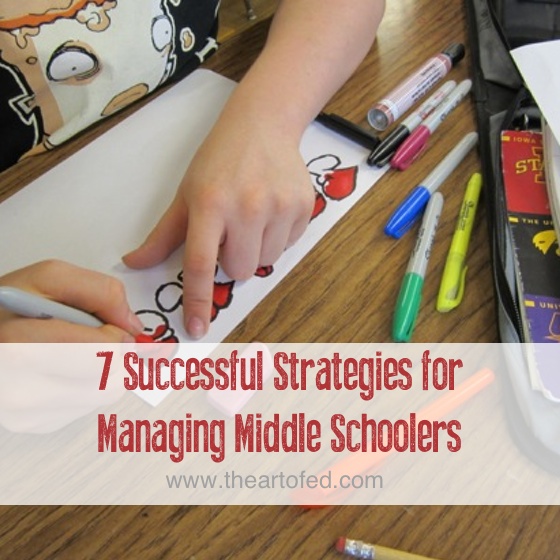
When people learn I teach middle school art, the response I frequently hear is “Oh, I’m sorry, I could never teach middle schoolers.” When my full time elementary art position was cut and I was moved to my current position teaching middle school art, I thought the same thing.
After some years of experience, and a lot of trial and error, I finally feel like I can teach middle schoolers. I might go as far to say I actually love teaching middle schoolers. (Yikes, I never thought I’d say that!) They’re independent, yet they still need me. They can create more detailed and difficult art projects than elementary students yet have the same excitement when I introduce a new material. On the other hand, there is their new found interest in themselves, sports, technology, and the opposite sex. Sometimes, these things get in the way of learning and create management problems in the classroom.
Here are 7 strategies to help you manage middle schoolers in the art room.
1. Create a system for getting students attention that you use EVERY time.
For example, when I want to get my students attention, I say “If I could have your attention in… five… four… three… two… one, hands free… eyes on me.” This gives students roughly eight to ten seconds (depending on how fast I say it) to give me their attention. I say “hands free, eyes on me” because a lot of my students continue working or keep their writing utensils in their hands and “beat” on their desks while I’m talking. This phrase reminds them to empty their hands. Using the same phrase over and over again helps create consistency.
2. Stop, stare and smile.
When I’m giving directions or teaching, and students are having sidebar conversations, I say, “I’m going to wait a couple seconds because some people are talking, and what I have to say is important.” Then I literally stop teaching, stare and smile at the student(s) talking until they get quiet.
3. Call or email parents.
No students want their parents to know if they’re not following directions, especially if it means they might loose privileges to technology devices or other personal freedoms. Create consistent consequences in your classroom. Since middle schoolers talk to each other, when you’re consistent, news spreads quickly.
4. Talk to extracurricular activity and sports coaches.
The coaches in my school are very supportive and understand that academics come first. Sometimes what I try doesn’t work, so I have to call for backup. Sometimes all it takes is a coach benching a student for his or her behavior to improve in class.
These 7 tips will go a long way in getting you started on the right foot with your middle schoolers. If you’re looking for even more in-depth info, we’ve got you covered. Take a look at the Managing Middle Schoolers PRO Learning Pack. You’ll learn how to better connect with your students, set clear expectations, and maintain a classroom that is fair and consistent. If you’re just starting at the middle school level, you can also dig into Surviving Your First Year of Middle School Art for more helpful advice!
5. Use positive support.
When you talk to your students, try to stay positive, not negative. For example, at the end of the class, every time the bell rings I say “thank you for pushing in your chair” instead of “push in your chairs please.” Keeping it positive gives the students a compliment and also helps remind those students who forgot without nagging them. It never fails, students who forgot to push in their chairs go back and push them in after I say thank you.
6. Establish opening procedures.
My students know when they come into my classroom, they do one of two things. If there is an art history image on the board they get out their art history journals and start journaling. If there is nothing on the board, they sit down and wait for me to take attendance. This allows them to calm down after an unstructured and sometimes rowdy four minute passing time.
7. Don’t embarrass students.
When students act up, the last thing you want to do is embarrass them in front of their peers. They get defensive and it makes the situation worse. They also are much less apt to apologize and admit their mistakes. When a student acts out, I say something like, “Cassidy, will you please go out in the hall, I will talk to you shortly.” Then I give them some time alone to reflect and calm down.
Overall, my best advice for managing middle schoolers is to reflect on what is and isn’t working. It’s all about trial and error. What works for me, might not work for you. Remember, if you’re having trouble with classroom management; consistency is key.
What strategies do you have for managing middle schoolers?
Share your best classroom management tip in the comments below!
Magazine articles and podcasts are opinions of professional education contributors and do not necessarily represent the position of the Art of Education University (AOEU) or its academic offerings. Contributors use terms in the way they are most often talked about in the scope of their educational experiences.




